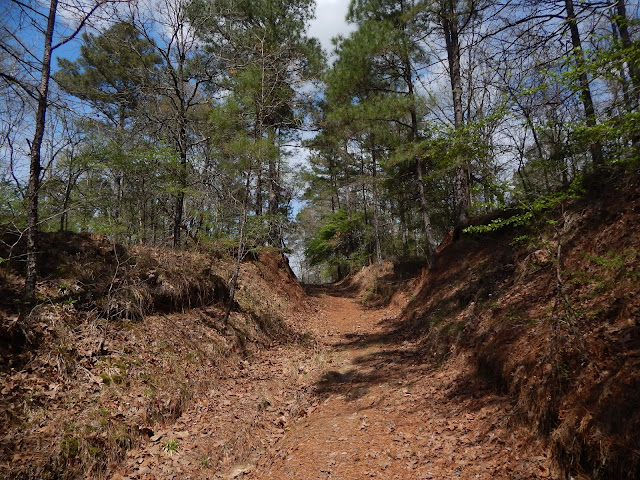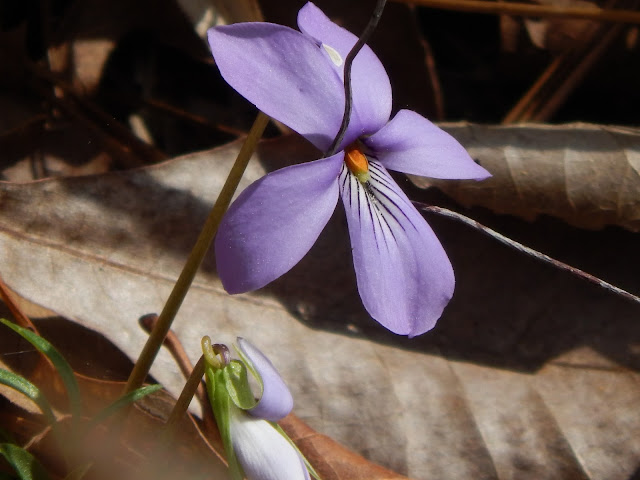 |
| a pond in the Sicily Island Hills |
******************************************************
Craig Marks -- the guy who literally wrote the book on Louisiana butterflies -- organized a group outing to go in search of Yucca Giant-Skippers (Megathymus yuccae) in the Sicily Island Hills, located in northern Catahoula Parish. These skippers had been reported from multiple locations in the J.C. "Sonny" Gilbert State Wildlife Management Area (WMA) (better known as Sicily Island Hills WMA). The Yucca Giant-Skipper has proven hard to find in Louisiana, so a chance at observing and documenting this skipper would be of interest to Bayou State butterflyers. Well, I'll spoil the ending now: we were unsuccessful in finding any Yucca Giant-Skippers, but it was an interesting and otherwise productive day in the field.
For more info on the Yucca Giant-Skipper, check out: https://www.butterfliesandmoths.org/species/Megathymus-yuccae & https://bugguide.net/node/view/3738.
We planned to meet at the WMA at 10:30 am, which meant that I had plenty of time to do some birding along the way. Besides some casual attempts and incidental stuff along the roads through La Salle and Catahoula Parishes, I made two serious stops, both at Harrisonburg, across the river from downtown.
Curious about swallows colonizing the new LA-8 bridge over the Ouachita River at Harrisonburg, I went down the old LA-8 spur on the east side of the river, which runs beside the new route and bridge, on their north side. Stopping shortly before the blockade, just past a side road that turns toward the bridge on the left, I found a decent spot to watch and listen - not too close to houses, with a weedy field on one side, trees on the other, the bridge pretty close, and the river not too far ahead. Three Barn Swallows were apparent from the start. Eventually, I drove down the side road that goes under the bridge. I turned around when it became apparent that it leads to houses, preferring not to end up turning around in someone's driveway. However, while on the south side of the bridge, closer to it, I did finally see some Cliff Swallows -- at least three. They were my FOS. Complete list from this location is below.
Harrisonburg at bridge:
9:29 am - 30 minutes
habitat shots:
 |
| end of the road for old LA-8 route |
 |
| new bridge -- Cliff Swallow spot |
Red-tailed Hawk - 1
Killdeer - 1
Eurasian Collared-Dove - 3
Mourning Dove - 2
Belted Kingfisher - 1
Red-bellied Woodpecker - 1
Downy Woodpecker - 1
Blue Jay - 2
crow sp. - 3
Barn Swallow - 3
Cliff Swallow - 3
Sedge Wren - 2
Carolina Wren - 2
Ruby-crowned Kinglet - 1
Northern Mockingbird - 4
European Starling - 10
Yellow-rumped Warbler - 1
Savannah Sparrow - 1
Swamp Sparrow - 2
Eastern Towhee - 1
Northern Cardinal - 5
Red-winged Blackbird - 2
Brown-headed Cowbird - 1
House Sparrow - 9
After that, with ~20 minutes to kill, I made my second stop the Harrisonburg Recreation Area, located at the end of LA-922 just north of its intersection with LA-8 and not too far from the bridge. This was my first time visiting the H-burg Rec. Area, and I think this park-like setting on the river bank has potential as a good birding spot. While there, I spotted two female Black Swallowtails, kicking off the day's butterflying.
 |
| Black Swallowtail at H-burg Rec. Area |
Harrisonburg Recreation Area:
10:02 am - 26 minutes
habitat shots:
 |
| boat launch at rec. area -- The Ouachita fat with flood water |
 |
| H-burg Rec. Area |
Turkey Vulture - 2
Mourning Dove - 1
Red-bellied Woodpecker - 1
Northern Flicker - 1
Blue Jay - 1
American Crow -
crow sp. - 6
Carolina Wren - 1
Ruby-crowned Kinglet - 1
Eastern Bluebird - 1
Northern Mockingbird - 4
Yellow-rumped Warbler - 2
Chipping Sparrow - 3
White-throated Sparrow - 4
Song Sparrow - 2
 |
| Song Sparrow |
Northern Cardinal - 6
Red-winged Blackbird - 2
And now on to the main event...
Sicily Island Hills:
Our group consisted of Craig Marks, Jeff Trahan, Dave Patton, Mac Myers, Brad Moon, and myself. We did the Hills in three parts; each section is described below. After that, the lists for Butterflies (and a few moths), Birds, Odonata (dragonflies and damselflies), Herps (amphibians and reptiles), Wildflowers, and "Miscellaneous" observations, each being a composite list of observations from the three segments described below.
...from south entrance off LA-8:
10:34 am - 2 hours, 56 minutes
2.5 miles by vehicle, ~0.5 mile on foot
Our meet-up point was the kiosk/sign-in station at the fork with the primitive campground road. We walked a good ways down the campground road, finding lots of yucca, but not the target skippers. Then we drove the main road further into the WMA, making some stops along the way, the final one at the Rock Falls Trail head. On the way back south, we walked a little ways down the next side road north of the campground road, before trying the campground road a second time.
habitat shots:
 |
| woods of the Sicily Island Hills |
 |
| down the primitive campground road |
 |
| next side road past campground road -- this location was logged a few years ago |
 |
| a promising spot along the main road |
...from north entrance off LA-915:
We drove to the trail head near the western-most of the cluster of ponds (the one with the bluff) and walked the short distance down to the pond. We then drove back around to the area around the east end of the ponds (including the big pond), making some stops along the way. We spent a good while down there, exploring the trails, ponds, woods, and roadside on foot. Some members of the group had to depart a bit early for the long drive home.
habitat shots:
 |
| trail to/from western-most pond |
 |
| trail near eastern ponds |
 |
| the big pond |
 |
| road at big pond -- the spot where we found Pepper and Salt Skipper, Phantom Cranefly |
...return to south entrance later in day:
Four of us made a second visit to the entrance off LA-8, parking just across that first creek and poking around the woods by the creek or walking up the road along the hill before calling it a day. Of primary interest here was the search for Odes that might be associated with the sandy springwater creek.
habitat shots:
 |
| wet woods by creek along south entrance |
 |
| from part way up the hill |
Butterfly List:
Thanks to Craig for putting together list and numbers (I made a couple of small additions).
Pipevine Swallowtail - 5
Spicebush Swallowtail - 2
Eastern Tiger Swallowtail - 9
Giant Swallowtail - 3
Falcate Orangetip - 9
Cloudless Sulphur - 1
Southern Dogface - pink-washed winter form (some or all?) - 7
Sleepy Orange - 1, possibly 2
Red-banded Hairstreak - 7
Pearl Crescent - ~ 15 - 20
Red Admiral - 3
 |
| Red Admiral |
 |
| American Lady |
Goatweed Leafwing - Abundant
 |
| Goatweed Leafwing |
Juvenal's Duskywing - Abundant
Lace-winged Roadside-Skipper - 4 - a lifer for me
 |
| Lace-winged Roadside-Skipper -- near primitive campgrounds |
...and a few moths:
(note: These are the best attempts at i.d. by this rank amateur.)
*presumably Archips georgiana - This suggested i.d. was accepted by BAMONA
 |
| apparent Archips georgiana |
 |
| Common Oak Moth (Phoberia atomaris) |
 |
| Vetch Looper (or similar-looking sp.) |
Eastern Tent Caterpillar Moth (Malacosoma americana) -
 |
| Eastern Tent Caterpillars -- appropriately, they were by the primitive campground |
 |
| caterpillar -- "When I grow up, I want to be a ___." |
Bird List:
Turkey Vulture -
Red-shouldered Hawk -
Mourning Dove -
Red-bellied Woodpecker -
Downy Woodpecker -
Pileated Woodpecker -
White-eyed Vireo -
Yellow-throated Vireo - my FOS
Blue Jay -
American Crow -
Purple Martin -
Carolina Chickadee -
Tufted Titmouse -
Brown Creeper -
Carolina Wren -
Golden-crowned Kinglet -
Ruby-crowned Kinglet -
Northern Parula -
Pine Warbler -
Yellow-rumped Warbler (Myrtle) -
White-throated Sparrow -
Eastern Towhee -
Northern Cardinal -
Brown-headed Cowbird -
American Goldfinch -
Odonata List:
provided by Dave Patton and Brad Moon
Orange Bluet -
Skimming Bluet -
Fragile Forktail -
 |
| tentative i.d.: Fragile Forktail |
Common Green Darner -
Swamp Darner -
 |
| Swamp Darner (Dig that chocolate-and-mint coloring!) |
Oklahoma Clubtail -
 |
| Ashy Clubtail |
 |
| Slender Baskettail |
Mantled Baskettail -
Blue Corporal -
Blue Dasher -
Common Whitetail -
Variegated Meadowhawk -
 |
| Variegated Meadowhawk -- What an attractive dragonfly! |
 |
| Variegated Meadowhawk |
Herps:
Blanchard's Cricket Frog - one seen, I think some were heard as well
Cope's Gray Treefrog - heard in several locations
Green (Bronze) Frog - heard
Southern Leopard Frog - heard
American Alligator - in one of the ponds in north section of WMA
 |
| American Alligator |
Wildflowers:
(note: These are the best attempts at i.d. by this rank amateur.)
Phlox sp. - One or more species common throughout the Hills
 |
| Phlox sp. |
 |
| hawthorn in bloom |
 |
| Crossvine blooms |
 |
| The May Apple's interesting arrangement of just two big umbrella-like leaves, with one white flower growing at the axil, can be seen clearly in this example. |
 |
| close-up of May Apple flower |
 |
| a patch of May Apple |
 |
| Birdfoot Violet |
 |
| Birdfoot Violet |
 |
| Violet sp. |
dewberry/blackberry sp. (Rubus) - also popular with the butterflies.
wakerobin sp. (Trillium) -
woodsorrel spp. (Oxalis) -
white clover sp. (Trifolium) - It was St. Patrick's Day, after all.
 |
| clover |
...just to name a few.
Miscellaneous:
Insects beyond the Lepidoptera and Odonata were noted by members of the party who are skilled in that area (which doesn't include me!). Phantom Crane Fly (Bittacomorpha clavipes) was one such species. Brad located this one in a swampy ditch near the big pond and I was pleased to get some decent photos of it.
 |
| Phantom Crane Fly |
The forest and landscape itself is interesting. There is a lot to take in when out in these scenic, rich, biologically diverse woods. I'm looking forward to more visits this spring and summer.
 |
| ... |
 |
| ... |

No comments:
Post a Comment